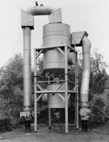
Bernd & Hiller
Becher,
Agregate, Cooking Plant
Heinrich Robert,
Ruhr Valley, black
& white photograph,
60cm x 47cm, 1987.
|
The monumental photographs
of Thomas Struth, Thomas Ruff, Andreas Gursky and Candida
Höffer are now exhibited and collected by public
galleries worldwide. This touring exhibition, curated by
Wulf Herzogenrath in cooperation with the German
Institute of Foreign Cultural Relations, pays homage to
the crucial role of their less well known mentors, Berndt
and Hilla Becher, who taught them, and a whole generation
of German art photographers from the Düsseldorf Academy
of Art. If their pupils have surpassed them in
achievement and fame, this exhibition allows us to
perceive the pupils' debt to their teachers. And it is
not altogether a benign debt or an untroubled legacy. Very
systematically, with ascetic rigour and painstaking
precision, the Bechers set about documenting the
disappearing industrial landscape: the abandoned
factories, water towers, gasometers silos and coal shafts
of post-industrial Germany. In an exhaustive series, they
shot each building in splendid isolation. All buildings
are alike, perfectly centred, uniformly lit, monumentally
positioned, finely detailed in printing and austerely
colourless.
The comprehensive documentation, the recourse to
typology and the clinical eye is reminiscent of August
Sanders. But where Sanders' documentation of the range of
human types populating Weimar Germany was
anthropomorphic, the Bechers devote the same documentary
zeal and pseudo-scientific precision to obsolete, dead
matter. This precision is harnessed to a landscape
populated by deserted and silent buildings, a direct
contrast to the Neue Sachlichkeit photographers
whose interests were in the dynamic and dramatic
functionality of the industrial machine.
The dedicated pursuit of a dead landscape and it's
enshrinement on perfect classical form betrays a certain
archaeological bent but also smacks of necrophilia and
repressive passion to control. It is a desire whose
refusal is to embrace the living, moving and changing
present. The dead past is more attractive than the living
present because it can be controlled, ordered and
designed.
The Becher's students have launched into colour and
extremely larger formats, as well as a wider range of
subjects. Yet they retain a preference for bright natural
lighting, a direct gaze which is quasi-scientific and an
unsentimental tendency for formal abstraction, all of
which takes its toll on the human figure. When present,
as in Andreas Gursky's urban landscapes and domestic and
public architectural interiors, the human figure is
dwarfed. Even in Thomas Struth's more intimate family
portraits, the formal posing, unsmiling inscrutability
and immobility of the human form works like an empty
mirror.
The suppression of the live and the human is
accompanied by other austerities. Like the Becher's work,
Petra Wunderlich's abandoned quarries and urban exteriors
are bereft of colour. Axel Hütte's penchant is also for
icy abstractions and minimalist colour. In direct
contrast to this harshness is Simone Niewig's series of
bright and disorderly market gardens and Jörg Sasse's
mundane domestic corners. Red hot shower caps on a wall
peg, the tightly coiled and twisted hose on a washing
machine, the dramatic red bowl on a high top shelf evoke
the passions and tensions seething in the nooks of
crannies of domestic life.
Sasse's work is, however, an aberration in context of
this exhibition. While all the photographs are
technically impressive and masterful, there's a dead
centre at play which represents an extreme endpoint to
the German Enlightenment need for the triumph of
scientific reason, ordered formality and repressive
discipline. There is no attempt to make judgments about
the human impersonality of economically rationalist and
postindustrial society. The Bechers do not mourn the deju
disparu of the industrial landscape but clinically
display it like the fossil of a defunct civilisation.
Where the Becher's documented the death of industrial
capitalism, Candida Höffer treats the problem
historically. She documents the death of history and the
incarceration of the corpse in the museum.
Culturally and geographically linked to Distance
and Proximity is Alex Rizkalla's . . . we all
fall down. Rizkalla has recently completed an
18-month residency at the Kunstlerhaus Bethanian in
Berlin. His latest project documents the body culture of
health and hygiene movements in Germany from their
leisurely beginnings in the late 19th century to their
cooption by the state and apotheosis in Nazi eugenics and
militarism. Rizkalla constructs a museum which includes
reproductions of old photographs beautiful bodies
performing exercise drills in military formations, and
glass vitrines stocked with displays of old hospital
equipment and prosthetic apparatuses.
But in the installation in a second, darkened room,
the projection of individual bodies moving lightly and
frenetically over a cluster of hospital enamelware
suggested that the body can elude discursive and real
institutional straightjacketing. Rizkalla suggests that
the pleasures of movement and exercise can be liberatory
and that aspiration towards free expression survives the
harshest regimes of repression. Amid the surrounding doom
there's a perceivable hope, or that may be wishful
thinking.
|
![]()